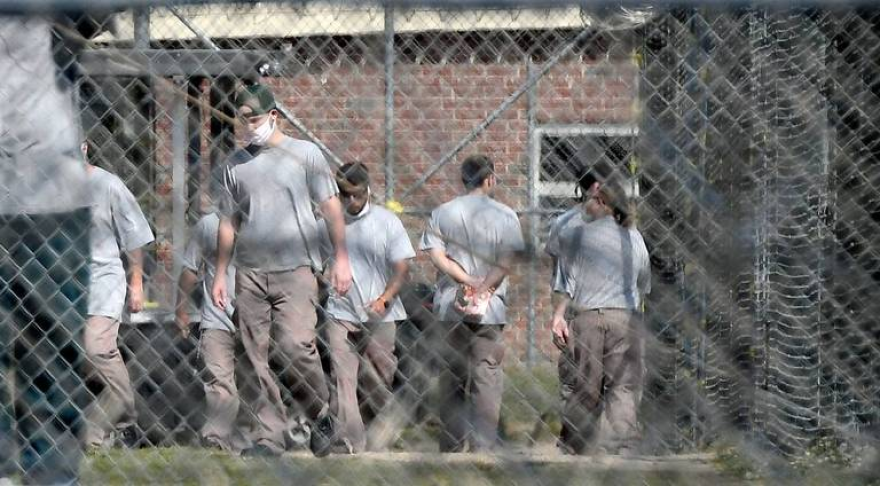A day after North Carolina prison leaders reported their first case of COVID-19, about 200 inmates at Neuse Correctional Institution refused to go back to their dorms.
In the prison's recreation yard on April 2, they staged a protest over new restrictions aimed at slowing the spread of the disease at the Goldsboro facility, where two inmates had already tested positive.
Some of the inmates, said state prisons commissioner Todd Ishee, threatened violence.
In response, officials stuck 36 of the protesters on a bus and shipped them more than 140 miles away to Pasquotank Correctional Institution, a maximum security facility outside Elizabeth City without a single diagnosed case of the virus.
Prison officials took the inmates' temperatures and asked about symptoms before transporting them. But they didn't test the men for COVID-19.
Soon after arriving at the facility, 19 of them tested positive.
State records show North Carolina officials continued to transfer thousands of inmates as COVID-19 raced through the state's prisons — actions that public health experts say raised the risk of spreading the virus. The Pasquotank transfers, in particular, were among dozens of cases in which the state Department of Public Safety transferred people from prisons with active COVID-19 cases to prisons with no known cases.
DPS data shows that since the beginning of April, when the first cases of COVID-19 were reported in the prisons, staff transferred more than 4,800 inmates between prisons, many more than once.
Prisons staff transferred more than 1,100 inmates from April 12 to May 25 — a period when DPS officials said they were sharply limiting transfers because of the threat posed by the coronavirus.
State prison officials say they've taken steps to minimize the risk of transmission and note that they significantly slowed the pace of transfers after the first cases of COVID-19 were detected in the prisons. Prior to the pandemic, they say, they typically transported 1,100 inmates a week.
But public health officials say each time prisons move inmates, they increase the chances the virus will be spread. And they say that's particularly true in states like North Carolina, where relatively few inmates have been tested. Fewer than 9 percent of the state's 31,000 inmates had been tested as of Wednesday, according to DPS data.
"You're moving from a high-risk environment to a high-risk environment," said Anthony Santella, an associate professor of public health at Hofstra University in New York who has studied efforts to prevent illnesses in jails and prisons. "And in between, you have many opportunities for additional exposure."

'It's A Recipe For Bad Things To Happen.'
A North Carolina judge recently ordered a temporary stop to many of the transfers. , Wake County Superior Court Judge Vinston Rozier Jr. said that the prisons must stop transferring inmates — unless they need to be moved for medical reasons or because of a serious risk to their safety — without first testing an inmate or putting him or her in medical isolation for 14 days after being transferred.
State prison conditions are likely unconstitutional, Rozier wrote, citing the continued transfers, the lack of testing and different levels of protection from the virus across prisons. In statements to the court and to a network of journalists across the state, public health experts have said all three variables — limiting transfers, testing and providing uniform protections — work together to prevent the spread of COVID-19.
The judge's ruling came in response to a lawsuit filed by the ACLU of North Carolina and other civil rights groups, which argue that the actions of prison leaders have left inmates vulnerable to contracting COVID-19.
"Defendants are transferring incarcerated individuals between facilities without properly protecting those individuals, or preventing the spread of COVID-19," the judge wrote in his order.
Experts say inmates are particularly vulnerable to COVID-19 and other infectious diseases because they live so close together and often receive inadequate medical care.
When viruses spread inside a prison, they endanger people on the outside, too. That's because staff members can carry the virus to their families and communities. So can some of the 2,000 people who are released from state prisons each month.
Testing inmates for COVID-19 is not part of the transfer procedure in North Carolina. But prison officials say they've been using other precautions — taking inmate temperatures and asking about any symptoms they have — before transferring them. They say they are also loading transport buses to only half their capacity to allow for social distancing. Where possible, they say, they are also housing transferred inmates together.
But several inmates interviewed for this story say people transferred to their prisons were simply housed in open dormitories, where prisoners sleep in beds just a few feet apart from one another.
"They're not getting quarantined, they're just coming in," said Quincey Hill, an inmate at Albemarle Correctional Institution — a prison in Stanly County where four inmates have tested positive for the coronavirus so far. "When they get transferred, they're coming right into an open dorm."
Dr. Homer Venters, who previously served as chief medical officer for the New York City jails, said moving inmates to open dorms can be dangerous.
"In the open dorms, it's very easy for the virus to be transmitted around very quickly," he said.

'Scared For Our Lives'
As people flow in and out of prison dorms, some inmates are worried.
On June 6, prison officials transferred about 35 women from the main campus of the N.C. Correctional Institution for Women in Raleigh to the Canary Unit, a separate minimum custody unit a block away, several inmates said.
The prisoners said one of the women who was moved is now sick, suffering from a fever, nausea, coughs and an inability to taste or smell.
Prison spokesman John Bull said DPS officials "aren't aware of any confirmed, active cases of COVID-19 currently at NCCIW."
Jordan Hillenbrand, another one of the women who was moved, said prison officials didn't test inmates or take their temperatures before moving them. She said she has been suffering from chills, a sore throat, nausea and a cough for the past week and a half. She has asked to be tested since April, she said, but prison officials have not yet tested her.
Raven Beard, who was also among those taken to the Canary Unit on June 6, said she, too, is worried about the way the prisons are moving so many inmates. She said she suffers from Hepatitis C and high blood pressure, which increase the risk for serious illness or death from COVID.
"I know we've done something wrong, but our lives shouldn't be put at stake," said Beard, who is doing time for identity theft.
NCCIW was the site of the second-largest outbreak of confirmed COVID-19 cases in the state prisons. More than 90 inmates at the prison tested positive after the state began doing widespread testing there starting in late April.
"We're scared for our lives," inmate Pamela Humphrey said. "We have people here going back to their families and loved ones. And they don't know if they're taking it home with them."
Publicly available data doesn't show how often the prisons move inmates from dorm to dorm within a prison — actions that public health experts say can also spread disease. But Bull, the prison spokesman, said staffers don't check the temperatures of inmates when moving them within a facility.

'You're Moving COVID-19'
On April 6, prison leaders announced they would begin sharply limiting prison-to-prison transfers in an effort to stem the spread of the virus. Soon afterward, officials halted the transfer of inmates from county jails to state prisons.
Transfers slowed in the weeks that followed, but the state kept moving hundreds of inmates from prison to prison. From April 12 to May 25, staffers transferred more than 1,100 prisoners, state data shows.
In mid-April, as COVID-19 swept through Neuse, prison officials tested all the inmates there and found that more than 460 of them were infected, making it one of the hardest-hit prisons in the nation.
On April 18, prison leaders temporarily closed Johnston Correctional Institution and sent that prison's staff to work at Neuse, where the corrections officers had been working in tough conditions and "desperately needed support," prisons commissioner Ishee said at the time.
Meanwhile, the inmates from Johnston were transferred to Southern Correctional Institution in Troy and to the Burke Confinement in Response to Violation Center in Morganton. That led to more transfers, as about 100 inmates were moved from Southern Correctional to make room for the inmates from Johnston.
State prison officials say the transfers that occurred from April 12 to May 25 represented just a small fraction of the number they typically moved before the pandemic.
State prison spokesman John Bull said many of those inmates were transferred to and from the Central Prison hospital for medical treatment, to restrictive housing or higher custody-level prisons because of poor behavior and to lower-custody prisons because of good behavior.
"In summary, these transfers were extremely limited. They were done for offender health reasons or were done to maintain the safe and secure operations of the prisons during a pandemic," Bull wrote in response to questions from a seven-newsroom collaborative.
On May 26, the prisons announced they were resuming many prison-to-prison transfers.
Soon afterward, officials resumed other transfers, moving large numbers of inmates from county jails to state prisons.
From May 26 to May 29, more than 60 inmates were transferred to Neuse — the prison where the state's largest COVID-19 outbreak had occurred the previous month.
When an attorney for one of those inmates expressed concerns about the move, a state DPS lawyer responded by email that Neuse had returned to normal operations and said the agency was "not in a position to permit COVID-19 concerns to prevent it from fully utilizing available space at operational facilities."
All told, more than 2,600 inmates were moved to new prisons between May 26 and June 12, records show.
Several public health experts said it's all but impossible to follow best public health practices when so many inmates are being moved.
"Moving people means you're moving COVID-19," said Alison O. Jordan, a public health consultant from New York who has expertise in jails and prisons. "And you're exposing more people in more communities every time you do it. It's just the math."
'Inmates Are More Vulnerable Than We Are.'
The moves are worrying family members too.
On June 1, Meagan Singleton's husband was transferred from Caledonia Correctional Institution in northeastern North Carolina to a prison 250 miles to the west — Alexander Correctional Institution, in Taylorsville. He'd asked to be moved to a medical unit to help him with his asthma, Singleton said.
The inmate, who asked not to be named because he fears retaliation, was moved to a minimum custody dorm, where the bunk beds are less than 3 feet apart, Singleton said. She questioned why her husband was not tested for COVID-19 before the move or after.
In April, two officers who worked in her husband's dorm at Caledonia — and at least two inmates who lived there — became ill with COVID-19, she said. State records show 17 inmates at Caledonia have tested positive so far.
"I don't think transporting so many inmates is responsible," Singleton said. "Inmates are more vulnerable than we are. There are so many inmates in one room. It's like a petri dish of COVID-19."

This story was jointly reported and edited by Jordan Wilkie and Frank Taylor, of Carolina Public Press; Ames Alexander, Gavin Off and Doug Miller of The Charlotte Observer; Dan Kane and Jordan Schrader, of The ąĎÉńapp & Observer; Nick Ochsner, of WBTV; Emily Featherston, of WECT; Tyler Dukes, of WRAL; and Jason deBruyn, of ąĎÉńapp-FM.









